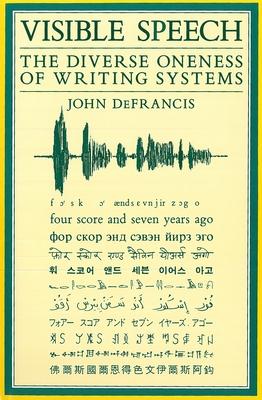Visible Speech is an attempt to set the record straight about the nature of writing. John DeFrancis, a noted specialist in the Chinese language, shows that writing can be based only upon a sound system and not upon any other linguistic level. He corrects the erroneous views of Chinese writing as pictographic, ideographic, logographic, or morphemic, and defends his conclusion that because of these misrepresentations, the nature of all writing continues to be misunderstood.
Using the writing systems of Sumerian, Egyptian, Arabic, Japanese, Korean, Greek, Mayan, and English, among others, to illustrate his points, Dr. DeFrancis stresses their basic identity as representatives of visible speech, while noting their secondary differences as manifested in their diverse script forms. He proposes a new classification of writing systems based on this theme of diversity and oneness, and makes an impassioned case for the essential phonetic component of all writing. This book reflects the author's sound scholarship and novel insights, which place it in the forefront with such classics on writing as those by Gelb, Diringer, Cohen, Fvrier, and Jensen. The readable style aims at a general audience interested in understanding the nature of the symbols that first strike the eye, while the academic research involved makes it an indispensable work for scholars in the many fields related to language and linguistics.
Visible Speech is an attempt to set the record straight about the nature of writing. John DeFrancis, a noted specialist in the Chinese language, shows that writing can be based only upon a sound system and not upon any other linguistic level. He corrects the erroneous views of Chinese writing as pictographic, ideographic, logographic, or morphemic, and defends his conclusion that because of these misrepresentations, the nature of all writing continues to be misunderstood.
Using the writing systems of Sumerian, Egyptian, Arabic, Japanese, Korean, Greek, Mayan, and English, among others, to illustrate his points, Dr. DeFrancis stresses their basic identity as representatives of visible speech, while noting their secondary differences as manifested in their diverse script forms. He proposes a new classification of writing systems based on this theme of diversity and oneness, and makes an impassioned case for the essential phonetic component of all writing. This book reflects the author's sound scholarship and novel insights, which place it in the forefront with such classics on writing as those by Gelb, Diringer, Cohen, Fvrier, and Jensen. The readable style aims at a general audience interested in understanding the nature of the symbols that first strike the eye, while the academic research involved makes it an indispensable work for scholars in the many fields related to language and linguistics.Hardcover
$39.06